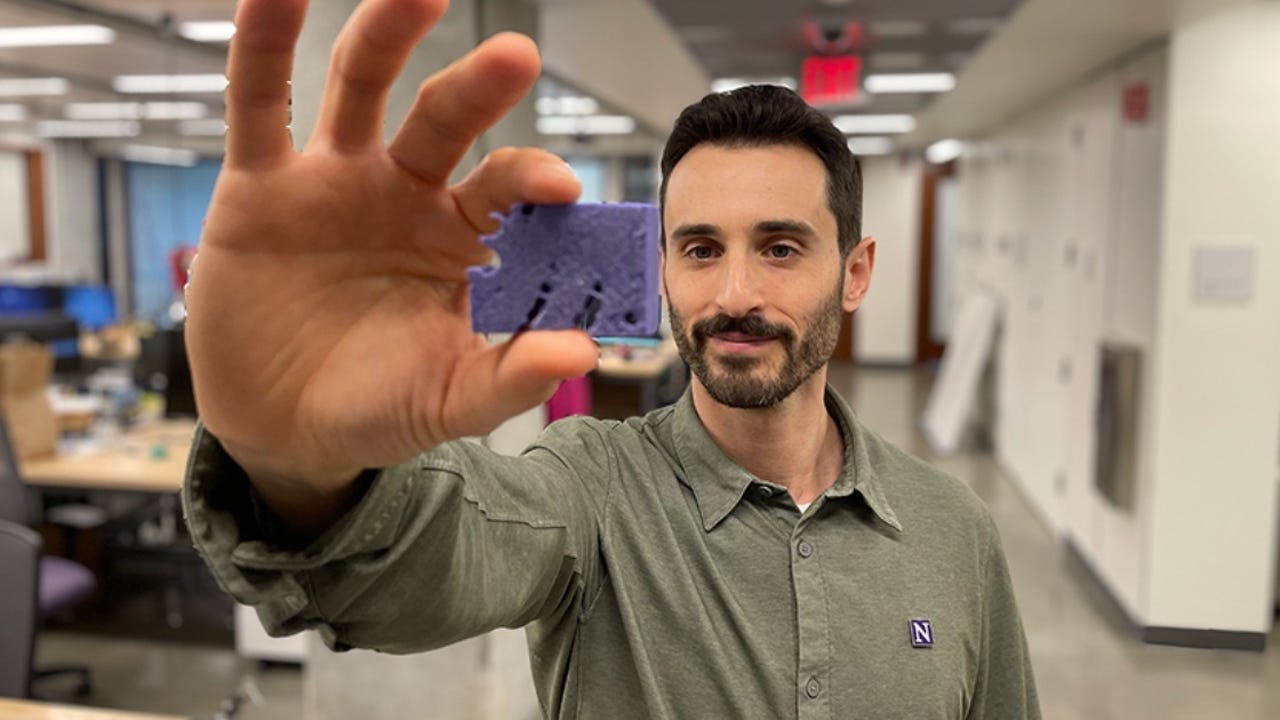
































Nortwestern University's Prof. Sam Kriegman and his 'insta robot'
Sam Kriegman, a professor at Northwestern's McCormick School of Engineering, is something of a local celebrity.
He can often be found on television shows explaining the wonders of his new invention -an insta-robot.
In one TV appearance, Kriegman places his insta-robot on his palm to show it off -- a purple-grey, gelatinous, squishy object with a few holes that looks a little like what you imagine a rhinoceros's ancestor to be.
Also: Robots plus generative AI: Everything you need to know when they work as one
He then attaches a flexible pipe to the robot and starts pumping. The jelly-robot kicks its legs out and -- in perhaps the first robotic imitation of the moonwalk -- begins to move backward. (You can watch the video here.)
It may all appear a bit underwhelming, a DIY toy from a science fair that you brought home to your five-year-old.
The truth is, however, that it may be a revolutionary moment in robot design with far-reaching implications for many aspects of human life -from exploration to rescue efforts to medicine.
"When people look at this robot, they might see a useless gadget," says Kriegman. "I see the birth of a brand-new organism."
Imagine a future where you need to rescue people trapped under rubble, deliver a life-saving medicine in a hard-to-reach part of the body, or engineer a shutdown of a nuclear reactor in a heavily contaminated space.
Pretty much any of these scenarios would require a lightning-quick turnaround from conceptualizing a solution to fabricating and testing it before deployment.
This 'insta robot' was designed by AI to replicate a process of evolution while catering to a specific prompt
None of this has been cheap or easy. Just the trial-and-error process of coming up with a solution takes months if not years.
There are evolutionary algorithms that look to nature for ideas when designing robots -- but they require churning out vast datasets, which in turn requires a supercomputer and many days to arrive at a solution.
We're not even going to get into the astronomical sums and countless hours spent on a robot design project.
Also: 15 big ideas that will revolutionize industries and economies, led by AI
Yet, here is Kriegman wielding a puny laptop by comparison, typing in the words "Design a Robot that can walk" that results in a blueprint for a functioning prototype in a bewildering 26 seconds.
"Evolving robots previously required weeks of trial and error on a supercomputer, and of course, before any animals could run, swim or fly around our world, there were billions upon billions of years of trial and error,' says Kriegman.
"This is because evolution has no foresight. It cannot see into the future to know if a specific mutation will be beneficial or catastrophic. We found a way to remove this blindfold, thereby compressing billions of years of evolution into an instant."
Also: Generative AI filled us with wonder - but all magic comes with a price
As Kriegman and Matthews explain in their recent paper, in those 26 seconds, the computer methodically built upon each version until it was satisfied that it had generated a workable solution.
From a jello-like bar of soap, to something that bounces in one spot, to something with holes in it (to make it lighter), to an object with fins and three legs, the algorithm arrived at a model that can hop and then shuffle.
"It's interesting because we didn't tell the AI that a robot should have legs," Kriegman said. "It rediscovered that legs are a good way to move around on land. Legged locomotion is, in fact, the most efficient form of terrestrial movement." (Kriegman notes that one exercise which forced the AI to use pre-designed musculature didn't produce legs.)
Also: Generative AI can easily be made malicious despite guardrails
Each version of the robot -- out of nine attempts -- was an improvement over its predecessor, until the ninth version produced the desired outcome -an object that could walk half its body length per second when air was repeatedly pumped into it to simulate expanding and contracting muscles that produce locomotion.
Of course, to get to that result Kriegman's team had to make a 3D-printed mold of the object's design generated by the algorithm and fill it with liquid silicone rubber, after which it was cured like an ancient dinosaur jello treat.
There are a few intriguing takeaways from this experiment.
First, the feat of compressing millions of years of evolution into just 26 seconds is an indication of the speed at which solutions can be found for intractable problems -- how to destroy an asteroid hurtling towards earth, or develop drugs for cancer, or link diseases to genetics.
Second, it takes a leap of imagination to shift your preconceived notions of functional design; for example, from thinking of chairs as four-legged to three-legged.
Also: How renaissance technologists are connecting the dots between AI and business
"When humans design robots, we tend to design them to look like familiar objects," Kriegman said. "But AI can create new possibilities and new paths forward that humans have never even considered. It could help us think and dream differently. And this might help us solve some of the most difficult problems we face."
Ultimately, it is about unlocking the vast store of resources lying in plain sight that we can't quite see as yet.
"The only thing standing in our way of these new tools and therapies is that we have no idea how to design them," Kriegman said. "Lucky for us, AI has ideas of its own."
 Горячие метки:
3. Инновации
Горячие метки:
3. Инновации